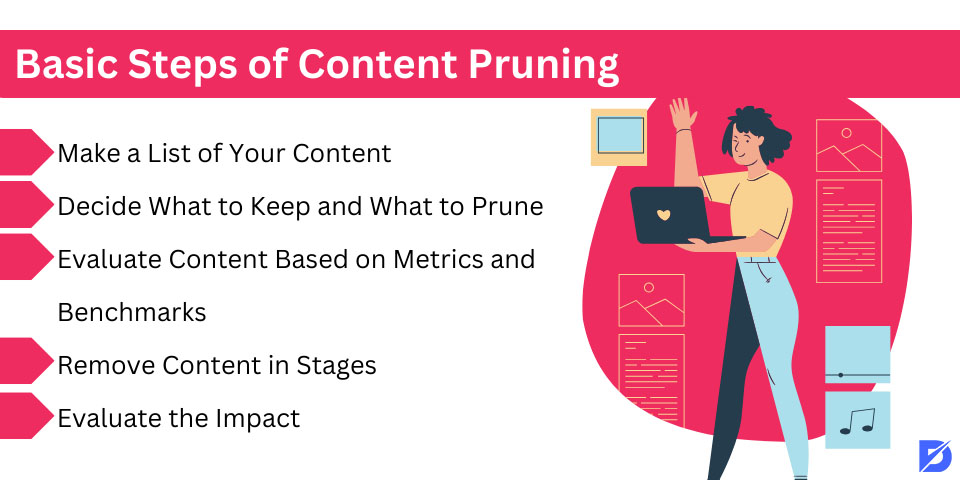Content pruning is like cleaning up a garden. It means looking at everything on a website and deciding what to keep, what to update, and what to throw away. The goal is to improve the website by eliminating old or unimportant stuff. This helps the website be more useful for people and makes it easier for search engines to understand. Just like taking care of a garden, regularly checking and cleaning up the content on a website keeps it fresh, organized, and more helpful for the people who visit.
Why Should Content Pruning Be Done?
Content pruning helps your website grow better and stay healthy. Some of the content pruning benefits are listed below:
- Make content better: Removing old or not-so-good content ensures that what’s left is helpful and meaningful for your audience.
- Help people find what they need: Keeping only the important stuff makes your website easier for people to use and find what they’re looking for.
- Get more visible on search engines: Search engines like websites with fresh and useful content pruning SEO.
- Focus on what matters: Removing things that don’t matter helps you concentrate on the main topics or things your audience cares about the most.
- Save resources: Getting rid of unnecessary content saves space and makes it easier to take care of your website.
- Stay up-to-date: Regular content pruning keeps your website in tune with what’s happening in your industry and what your audience is interested in.
- Make your website faster: A simpler website with good content tends to load faster, making it better for users and search engines.
What Should Be Considered During Content Pruning?
Content pruning is an important step to optimize the content on a website. Among the elements that need to be considered in this process are the relevance of the content to the main theme of the site, timeliness, relevance to keywords, and performance analysis. It is also important to fix broken links, update visual content, and make text readable. Making content more effective and meaningful by focusing on the needs of the target audience can improve website performance and increase visitor satisfaction. Instead of deleting old stuff completely, it’s smarter to carefully check and show off the new stuff via content pruning. This helps you figure out which content needs fixing or deleting more effectively.
Basic Steps of Content Pruning
Here are the basic steps of content pruning;
- Make a List of Your Content: Before you start cleaning up your content pruning, it’s best to do an audit. This means figuring out all the stuff you already have and any important details about it. If you have lots of articles, using a special tool is much easier. You can use website crawling tools like Screaming Frog or check Google Analytics and Google Search Console for content inventory.
- Decide What to Keep and What to Prune: To do this right, you need some criteria to help you decide. Using specific performance measures can guide you in deciding which articles to prune. Here are some things to think about: How old is the article? How many clicks did it get? What about past search traffic? How many backlinks does it have? Does it rank high for important keywords?
- Evaluate Content Based on Metrics and Benchmarks: Look at each item on your content list and note down the values for the performance metrics you’ve chosen. Ask yourself: What’s the average monthly organic traffic for the past six months for each link? How many backlinks does each piece of content have? You can get this info using tools like Google Analytics, Google Search Console, or Clearscope.
- Remove Content in Stages: Even if you’ve found the content to prune, it’s often better not to make all the changes at once. Doing it step by step helps you see how specific changes affect your SEO performance. Create a priority list and find the top candidates for removal.
- Evaluate the Impact: After each round of pruning, keep an eye on how your website’s overall traffic and search engine rankings change. Make the necessary adjustments, publish the changes, and move forward.

How to Do Content Pruning
Here are the best strategies for content pruning.
Identify Content that Is Indexed
First of all, identifying indexed content is important for understanding which pages of your website are recognized and stored by search engines.
- Google search: Use Google search by entering “site:yourwebsite.com” (replace “yourwebsite.com” with your actual domain) to see a list of pages indexed by Google.
- Google Search Console: Access Google Search Console and navigate to the “Index” section. Select “Coverage” to view a report on indexed pages.
- Webmaster tools: Check Bing Webmaster Tools or other search engine webmaster tools for indexed page information.
Identifying Pages with Low Rankings and Performance
Identifying pages with low rankings and performance is a critical aspect of maintaining a successful online presence. Utilizing tools such as Google Analytics, Google Search Console, and SEO platforms like Ahrefs, SEMrush, or Dopinger’s Rank Checker tool, website owners can assess various metrics, including page views, bounce rates, and search rankings. High bounce rates and low rankings may indicate issues affecting user engagement and search engine visibility. Additionally, conducting speed tests with tools like Google PageSpeed Insights helps pinpoint slow-loading pages.
Use Noindex
Noindex is like a sign on a webpage telling search engines, “Don’t put this page in your list.” When a page has this sign, search engines won’t show it in their results when people search. People use this sign for pages that have the same content elsewhere, are still being worked on, or aren’t supposed to be seen by everyone.
Develop Content
Content development is when you do research, analyze things, create, edit, make better, put out, and tell people about content. The goal is to achieve something important and planned. Not all your content needs to be thrown away; you can improve it with some basic on-page SEO. Adjust the title, meta description, or headings, add new sections about recent developments, and remove outdated parts to make it better for your content pruning.
Using the Canonical Tag
Think of a canonical tag like a guide in the code of your website pages. To put it simply, the canonical tag helps search engines decide which page to show in the search results. Without it, Google might treat different pages as separate search results. While this might not be a big issue for one page, it becomes a problem when you have a large website with many pages.
Pruning Your Content Efficiently
Pruning content efficiently means making your writing better by removing unnecessary stuff and making it clearer and more focused. Imagine your writing is like a tree – you want to cut away the branches that don’t add much so that what’s left is strong and meaningful. First, figure out why you’re writing and who you’re talking to. Make a plan before you start, and keep it simple. Get rid of extra words, check that everything makes sense, and use headings to help people follow along. It’s like giving your writing a trim to make it neat and effective, which is one of the greatest benefits of pruning content.
Frequently Asked Questions About
Content pruning involves the process of carefully reviewing and trimming unnecessary elements.
Getting feedback is important when you’re fixing up your writing because it helps you make it better.
Content pruning is used during outlining by helping to plan and organize your writing more effectively.





No comments to show.